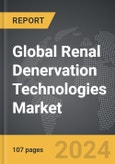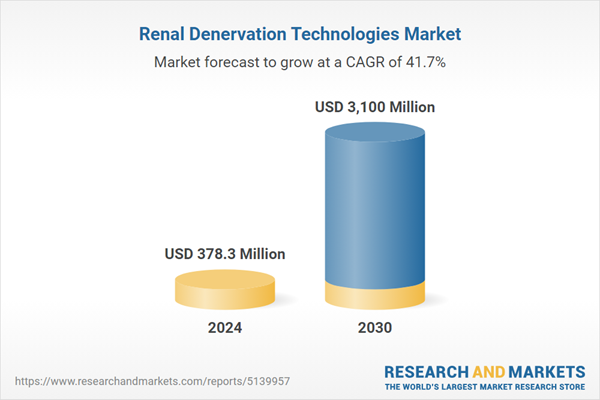Global Renal Denervation Technologies Market - Key Trends & Drivers Summarized
Renal denervation technologies represent a promising advancement in the treatment of resistant hypertension, a condition where high blood pressure remains uncontrolled despite the use of multiple antihypertensive medications. This minimally invasive procedure involves the use of catheter-based radiofrequency or ultrasound energy to ablate the renal nerves, which are located around the arteries leading to the kidneys. By disrupting the signals transmitted through these nerves, renal denervation aims to reduce sympathetic nervous system activity, thereby lowering blood pressure. The procedure is typically performed under local anesthesia and involves the insertion of a catheter through the femoral artery, guided to the renal arteries, where targeted ablation is conducted. The technique has shown potential not only in reducing blood pressure but also in offering sustained effects, making it an attractive option for patients who do not respond adequately to conventional therapies.Technological advancements have significantly enhanced the efficacy and safety of renal denervation procedures. Early clinical trials faced challenges with inconsistent results, prompting further innovation and refinement in the technology. Modern systems now offer improved catheter designs with better navigability and precision in delivering energy, which minimizes damage to surrounding tissues and enhances patient outcomes. Additionally, advancements in imaging and mapping technologies allow for more accurate targeting of the renal nerves, ensuring effective ablation. There has also been a growing interest in non-radiofrequency methods, such as ultrasound and chemical ablation, which provide alternative approaches with their own unique benefits. Continuous research and development are expanding the understanding of the physiological mechanisms underlying hypertension, leading to more effective and tailored renal denervation strategies.
The growth in the renal denervation technologies market is driven by several factors. The increasing prevalence of hypertension worldwide, particularly resistant hypertension, is a major driver, as it fuels the demand for innovative treatment options. Advances in medical technology and a deeper understanding of the pathophysiology of hypertension have led to the development of more effective and safer renal denervation systems. The aging global population, coupled with lifestyle factors such as poor diet and sedentary behavior, contributes to the rising incidence of hypertension, further expanding the potential market for these technologies. Additionally, the growing body of clinical evidence supporting the long-term benefits and safety of renal denervation is encouraging more healthcare providers to adopt this treatment modality. The push for minimally invasive procedures in modern medicine, driven by patient preference for treatments with shorter recovery times and fewer complications, also supports market growth. These factors collectively highlight the dynamic and rapidly evolving nature of the renal denervation technologies market.
Report Scope
The report analyzes the Renal Denervation Technologies market, presented in terms of market value (USD). The analysis covers the key segments and geographic regions outlined below.- Segments: Technology (Radiofrequency Based, Ultrasound Based, Micro-Infusion Based).
- Geographic Regions/Countries: World; USA; Canada; Japan; China; Europe; France; Germany; Italy; UK; Spain; Russia; Rest of Europe; Asia-Pacific; Australia; India; South Korea; Rest of Asia-Pacific; Latin America; Argentina; Brazil; Mexico; Rest of Latin America; Middle East; Iran; Israel; Saudi Arabia; UAE; Rest of Middle East; Africa.
Key Insights:
- Market Growth: Understand the significant growth trajectory of the Radiofrequency Based Technology segment, which is expected to reach US$2.1 Billion by 2030 with a CAGR of 41.3%. The Ultrasound Based Technology segment is also set to grow at 43.5% CAGR over the analysis period.
- Regional Analysis: Gain insights into the U.S. market, valued at $90.4 Million in 2024, and China, forecasted to grow at an impressive 51.7% CAGR to reach $249.9 Million by 2030. Discover growth trends in other key regions, including Japan, Canada, Germany, and the Asia-Pacific.
Why You Should Buy This Report:
- Detailed Market Analysis: Access a thorough analysis of the Global Renal Denervation Technologies Market, covering all major geographic regions and market segments.
- Competitive Insights: Get an overview of the competitive landscape, including the market presence of major players across different geographies.
- Future Trends and Drivers: Understand the key trends and drivers shaping the future of the Global Renal Denervation Technologies Market.
- Actionable Insights: Benefit from actionable insights that can help you identify new revenue opportunities and make strategic business decisions.
Key Questions Answered:
- How is the Global Renal Denervation Technologies Market expected to evolve by 2030?
- What are the main drivers and restraints affecting the market?
- Which market segments will grow the most over the forecast period?
- How will market shares for different regions and segments change by 2030?
- Who are the leading players in the market, and what are their prospects?
Report Features:
- Comprehensive Market Data: Independent analysis of annual sales and market forecasts in US$ Million from 2024 to 2030.
- In-Depth Regional Analysis: Detailed insights into key markets, including the U.S., China, Japan, Canada, Europe, Asia-Pacific, Latin America, Middle East, and Africa.
- Company Profiles: Coverage of players such as Abbott Laboratories, Inc., Boston Scientific Corporation, Medtronic PLC, Terumo Corporation, Otsuka Medical Devices Co., Ltd. and more.
- Complimentary Updates: Receive free report updates for one year to keep you informed of the latest market developments.
Some of the 13 companies featured in this Renal Denervation Technologies market report include:
- Abbott Laboratories, Inc.
- Boston Scientific Corporation
- Medtronic PLC
- Terumo Corporation
- Otsuka Medical Devices Co., Ltd.
- Ablative Solutions, Inc.
- Mercator MedSystems, Inc.
- Autonomix Medical
This edition integrates the latest global trade and economic shifts into comprehensive market analysis. Key updates include:
- Tariff and Trade Impact: Insights into global tariff negotiations across 180+ countries, with analysis of supply chain turbulence, sourcing disruptions, and geographic realignment. Special focus on 2025 as a pivotal year for trade tensions, including updated perspectives on the Trump-era tariffs.
- Adjusted Forecasts and Analytics: Revised global and regional market forecasts through 2030, incorporating tariff effects, economic uncertainty, and structural changes in globalization. Includes historical analysis from 2015 to 2023.
- Strategic Market Dynamics: Evaluation of revised market prospects, regional outlooks, and key economic indicators such as population and urbanization trends.
- Innovation & Technology Trends: Latest developments in product and process innovation, emerging technologies, and key industry drivers shaping the competitive landscape.
- Competitive Intelligence: Updated global market share estimates for 2025, competitive positioning of major players (Strong/Active/Niche/Trivial), and refined focus on leading global brands and core players.
- Expert Insight & Commentary: Strategic analysis from economists, trade experts, and domain specialists to contextualize market shifts and identify emerging opportunities.
Table of Contents
Companies Mentioned (Partial List)
A selection of companies mentioned in this report includes, but is not limited to:
- Abbott Laboratories, Inc.
- Boston Scientific Corporation
- Medtronic PLC
- Terumo Corporation
- Otsuka Medical Devices Co., Ltd.
- Ablative Solutions, Inc.
- Mercator MedSystems, Inc.
- Autonomix Medical
Table Information
| Report Attribute | Details |
|---|---|
| No. of Pages | 107 |
| Published | December 2025 |
| Forecast Period | 2024 - 2030 |
| Estimated Market Value ( USD | $ 378.3 Million |
| Forecasted Market Value ( USD | $ 3100 Million |
| Compound Annual Growth Rate | 41.7% |
| Regions Covered | Global |









